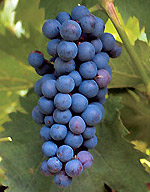Most foodies know that pignolo is Italian for pine nut. So, it was a big surprise when Andrew the sommelier at Felidia’s in NYC asked us if we’d like to try a Pignolo -we thought he was joking. He served us a 2000 Pignol from Bressan, a producer in Friuli-Venezia-Giulia. It was a great wine, having just the right notes of pepper and spice – it was med-full bodied but had sensational aromatics, with a nice after-taste of raspberry. So, we were intrigued, and wanted to learn a bit more about the Pignolo grape.
The grape is a native red variety grown predominantly in the Friuli-Venezia Giulia region of northeast Italy. Besides being the same name as the pine nut, it also means “fussy” in Italian, which very much describes the grape. So, it is no surprise that Pignolo wines are somewhat rare, with just a few dedicated producers. But it’s worthwhile to try to find, since the wines are typically well balanced (flavors, tannins, acidity). Look for the Bressan wine (about $60), Jermann (about $30), Livon (about $30), or Moschioni (a top-end producer – expect to pay about $100).



